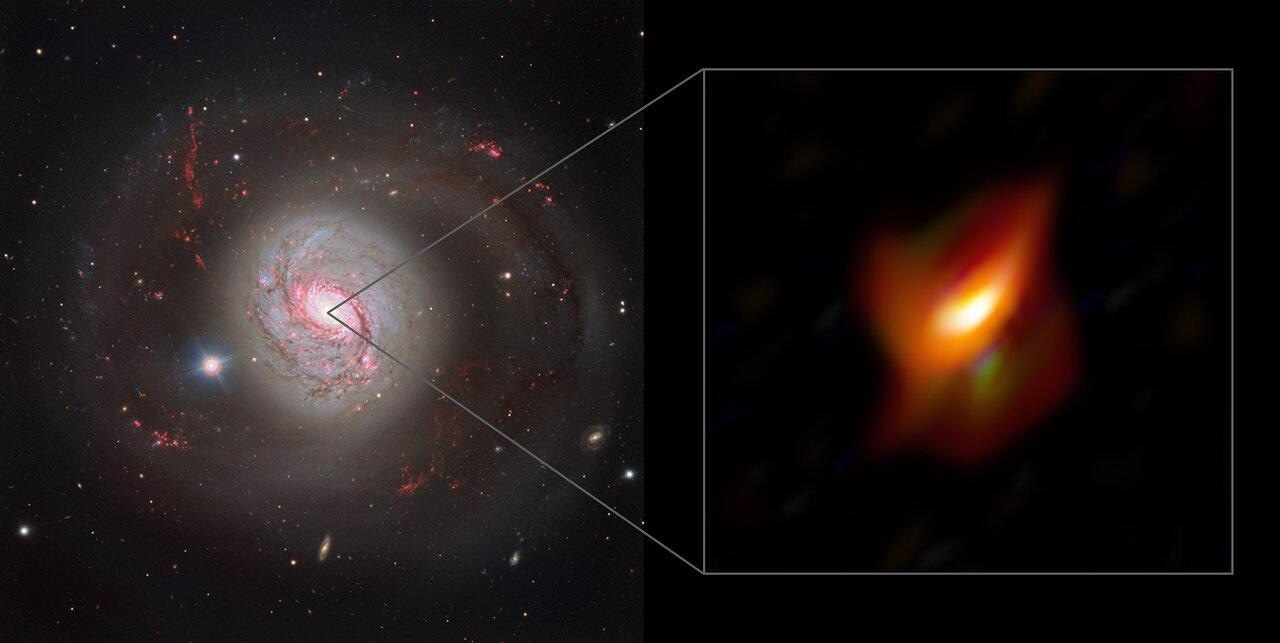A cloud of cosmic dust at the center of the galaxy Messier 77 hiding a supermassive black hole has been observed by the European Southern Observatory’s Very Large Telescope Interferometer (ESO’s VLTI). The results have proved predictions made nearly 30 years before and are giving astronomers a new vision into “active galactic nuclei,” which are some of the most enigmatic and brightest objects in the universe.
 Galaxy Messier 77 and close-up view of its active center. Image Credit: European South Observatory.
Galaxy Messier 77 and close-up view of its active center. Image Credit: European South Observatory.
Active galactic nuclei (AGNs) are very energetic sources that are powered by supermassive black holes and situated at the center of certain galaxies. These black holes consume huge volumes of gas and cosmic dust. Before being consumed, these substances spiral towards the black hole, and large amounts of energy are expelled in the process — mostly outshining all the stars present in the galaxy.
Astrophysicists have been inquisitive about AGNs ever since the 1950s when they first spotted these shiny objects. Now, a team of researchers, headed by Violeta Gámez Rosas from Leiden University in the Netherlands, has taken a key step towards studying how these bright objects function and appear from up close, thanks to ESO’s VLTI. The findings are published in Nature.
Gámez Rosas and her team identified a thick ring of gas and cosmic dust hiding a supermassive black hole by making outstanding elaborated observations of the center of the galaxy Messier 77, which is also called NGC 1068. The discovery offers crucial evidence to support the Unified Model of AGNs — a 30-year old theory.
Astronomers are aware of the fact that there are different kinds of AGN. For instance, some expel bursts of radio waves whereas others do not. In the same way, some AGNs shine luminously in visible light, whereas others, like Messier 77, are more passive. The Unified Model puts forth that all AGNs, despite their differences, have the same fundamental structure — a supermassive black hole that is surrounded by a thick ring of dust.
As per this model, any change in appearance among AGNs results from the orientation at which the black hole and the corresponding thick ring are viewed from Earth. The AGN type observed is based on how much the ring complicates the black hole from the viewpoint, fully hiding it in certain cases.
Some evidence has been found by astronomers to support the earlier Unified Model, alongside spotting warm dust at the center of Messier 77. Nevertheless, speculations remained whether this dust can hide a black hole completely and thereby elaborate on why this AGN glows less brightly in visible light than others.
The real nature of the dust clouds and their role in both feeding the black hole and determining how it looks when viewed from Earth have been central questions in AGN studies over the last three decades. Whilst no single result will settle all the questions we have, we have taken a major step in understanding how AGNs work.
Gámez Rosas, Researcher, Leiden University
The observations were made possible, owing to the Multi AperTure mid-Infrared SpectroScopic Experiment (MATISSE) fixed on ESO’s VLTI, situated in Chile’s Atacama Desert. MATISSE combined infrared light gathered by all four 8.2-meter telescopes of ESO’s Very Large Telescope (VLT) employing a method called interferometry. The researchers utilized MATISSE to scan the center of Messier 77, situated in the constellation Cetus at 47 million light-years away.
MATISSE can see a broad range of infrared wavelengths, which lets us see through the dust and accurately measure temperatures. Because the VLTI is in fact a very large interferometer, we have the resolution to see what’s going on even in galaxies as far away as Messier 77. The images we obtained detail the changes in temperature and absorption of the dust clouds around the black hole.
Walter Jaffe, Study Co-Author and Professor, Leiden University
Combining the dust temperature changes (from around room temperature to nearly 1200 °C) produced by the intense radiation with the absorption maps from the black hole, scientists constructed an elaborate picture of the dust and spotted where the black hole must lie. The dust, in a thick inner ring and a more extended disc, with the black hole located at its center backs the Unified Model.
To construct the picture, the team also employed data from the Atacama Large Millimeter/submillimeter Array — co-owned by ESO — and the National Radio Astronomy Observatory’s Very Long Baseline Array.
Our results should lead to a better understanding of the inner workings of AGNs. They could also help us better understand the history of the Milky Way, which harbors a supermassive black hole at its center that may have been active in the past.
Gámez Rosas, Researcher, Leiden University
Scientists are now planning to utilize ESO’s VLTI to seek more supportive proof of the Unified Model of AGNs by looking at a larger sample of galaxies.
Bruno Lopez, Team Member and MATISSE Principal Investigator at the Observatoire de la Côte d’Azur in Nice, France, says: “Messier 77 is an important prototype AGN and a wonderful motivation to expand our observing program and to optimize MATISSE to tackle a wider sample of AGNs.”
ESO’s Extremely Large Telescope (ELT), which will be ready to start observing later this decade, will also help the search, offering findings that will supplement the team’s results and enable them to analyze the communication between AGNs and galaxies.
Journal Reference:
Rosas, V. G., et al (2022) Thermal imaging of dust hiding the black hole in NGC 1068. Nature. doi.org/10.1038/s41586-021-04311-7.